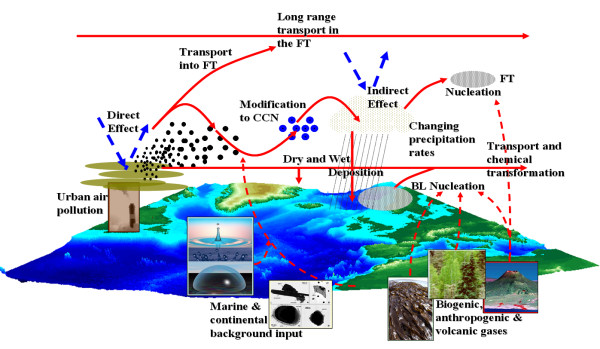Aerosol Research
Aerosol particles are important components in the Earth’s atmosphere. They have been shown to have an adverse effect on human health in urban environments, they can be effective pathways for deposition of pollutants and exchange of nutrients, they scatter and absorb radiation and so impact the heat balance of the atmosphere, and they can act as sites onto which cloud droplets and ice particles can form, thus affecting precipitation and also the reflective properties of the cloud.

To describe the effects of aerosol particles in the atmosphere we need to understand their lifecycle, quantitatively predicting their emission, transportation and transformation. The Group focuses its activities on developing this basic understanding using a combination of detailed field and laboratory measurements, and process and regional scale models. Further background information on aerosol processes relevant to our group activities may be found here
Our wide range of equipment and facilities gives us the ability to describe the physical and chemical properties of the particles in detail using measurements to test model predictions of the aerosol particle properties and allowing us to improve regional or global models of aerosol transport and transformation. Often models cannot be tested using field measurements as natural variability in the atmosphere obscures other important mechanisms. We replicate the atmosphere investigating aerosol properties and processes in a large chamber under controlled conditions, allowing closer scrutiny of key parts of the aerosol lifecycle.
We employ a range of model tools to inform large-scale process representations by the field and laboratory experiments. 0-D time invariant descriptions of multicomponent aerosol thermodynamics including effects on surface tension are used to reconcile measured composition and water uptake under cloudy and cloud free conditions. Time evolving 0-D and 1-D models can be used to simulate chemical and microphysical transformations to reproduce chamber and field observations. Detailed process understanding from these studies can be used in larger scale 3-D models, conducting regional aerosol simulations in-house and developing process parameterisations for global climate modelling in collaboration with the Met Office and other University groups.
A description of the research methodology that we employ can be found by following this link, the full range of tools that we use to link with our broader CAS activities, here and the projects in which we employ them, here.
Our research current foci include: aerosol processes and transformation; secondary organic aerosols; improved prediction and testing of the water content of aerosols and how effective they are as cloud condensation nuclei; halogen cycling in marine environments; primary marine aerosol and the role of surfactants; biomass burning aerosol; aircraft sampling of aerosols. Aerosol mass spectrometry, regional modelling of aerosol particles. Further details of our current research interests can be found here and selected research highlights here.